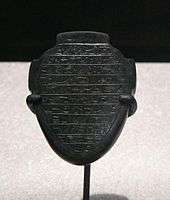
Heart Scarab.
The Heart scarab is an oval, scarab artifact dating from ancient Egypt. Mostly an amulet, it was also used as jewelry, a memorializing artifact, or a grave good. The heart scarab was used by referring to Chapter 30 from the Book of the Dead, and the weighing of the heart, being balanced by Goddess Maat, of Justice, Truth, & Order. As in many current religions, the individual had to show 'worthiness' to achieve the Afterlife. Another concept in Egyptian reliefs states the name of the individual being honored and saying: person xxx, the Justified, using two hieroglyphs.
The amulets are prescribed in the Book of the Dead to be made-(per Andrews, Amulets of Ancient Egypt)[1] of a stone: nmhf, nemehef, (not now identified); typically green stones, green jasper, serpentine, and basalt. Andrews continues to say they are in fact made from: green or dark-green materials, such as glazed steatite, schist, feldspar, hematite and obsidian; also blue-glazed composition (faience), Egyptian blue, rock crystal, alabaster or red jasper.
The alternate heart amulet-(shape) itself represents similar ideas, but is made in the form of the heart as used by the
Egyptian language hieroglyph.
Ancient Egyptian amulets
Besides the personal use of the amulet in life, the body was often provided with amulets in burial, with more amulets implying more protection. The most common funerary amulets were the heart scarab, Wadjet Eye, Djed Pillar amulet, Wadj amulet, Tyet amulet, and the Golden-vulture collar, (for goddess Mut). Amulet usage changed greatly over the millenniums of Ancient Egypt.
The papyrus stem,
or Wadj amulet was made from 'green feldspar' as prescribed in Chapter 160, Charpter 159 from the
Book of the Dead.
[2] The most common explanation for the amulet is that it provided 'eternal youth' to the deceased.
Gallery
Heart scarab, multiple types
Heart amulet
See also
References
- Andrews, 1994. Amulets of Ancient Egypt, chapter 4: Scarabs for the living and funerary scarabs, pp 50–59, Andrews, Carol, c 1993, University of Texas Press, 518 amulets, 1, or multiples included in 12 necklaces; (softcover, ISBN 0-292-70464-X)
- Budge, 1978, (1920). An Egyptian Hieroglyphic Dictionary, E.A.Wallace Budge, (Dover Publications), c 1978, (c 1920), Dover edition, c 1978; cliv-(154) and 1314 pp. (In two volumes) (softcover, ISBN 0-486-23615-3)
External links

 Heart Scarab, inscribed with Chapter 30, Book of the Dead
Heart Scarab, inscribed with Chapter 30, Book of the Dead Paser pylon pendant, with Heart scarab motif
Paser pylon pendant, with Heart scarab motif Hatnofer's heart scarab on necklace
Hatnofer's heart scarab on necklace Egyptian amulet examples:
Egyptian amulet examples: